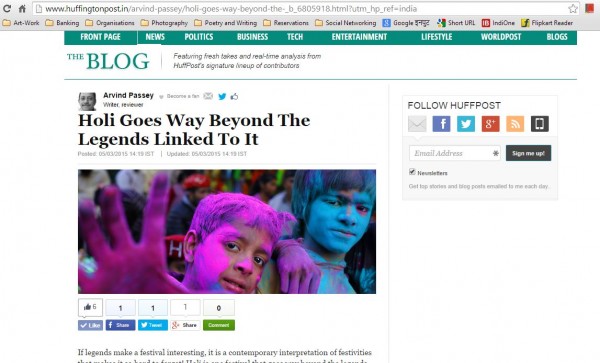If legends make a festival interesting, it is a contemporary interpretation of festivities that makes it so hard to forget! Holi is one festival that goes way beyond the legends linked to it and has formed its own identity.
I remember when I was in school I was mortally afraid of colours and so during Holi one was sure I had locked myself inside one of the bathrooms with a stack of novels to read. Holi was thus a boon to my reading habits… but then one year my parents showed me a tree and said, ‘This is the palash or tesu tree. The orange and the reddish orange flowers that you see are dried and then soaked in water and this is the colour that you can fill in your pichkari (water canon) to sprinkle during Holi.’
This connection of colours with plants fascinated me and that was one year that saw me standing on my first floor balcony with my bucket of saffron coloured water. It was exciting to fill my pichkari and let the spray surprise the small groups or ‘tolis’ of people who were coloured beyond recognition and dancing to the melody of harmoniums and the beat of the dhols that a few carried with them.
It isn’t so much different today. The colours have probably been through their chemically hazardous phase and come back to their organic avatars, the music is still rapturous though the beats have perceptibly picked up inspired nuances from certain Harlem Shakes and Gangnam Styles, the dance moves are probably zippier, and the interaction between the sexes is nippier! Holi is one time when colours transcend their physical self and then you can almost feel them in the air. Shades of pink gulaal, crimson abir, and canary yellow powder take over our imagination. Those who have a way with words are in demand to create immediate lines that are flirtatious and full of sexual innuendoes… and the real poets can still wash their colours in the evening to sit down, smile and write a few bawdy lines to be used in the coming year.
Yes, Holi isn’t just about colours. It is all about colourful interactions with emotions. It is all about letting reservations and inhibitions rest for a while and allow the rowdy inner self to lead the moment. This is a time when make-up comes down, pretensions are exposed with men and women out to show their true colors… quite literally! I’m quite sure all this helps people get more real in their lives and that is why one hears them chanting: “Bura na mano holi hai!” Holi is a time to forgive & forget all wrongs of the past and begin new friendships. This is one festival where everyone has the right to be entertaining… yes, and I’m sure even the Gods watch from wherever they are and laugh at all this turbo-entertainment going on. It is colours that reach out to hearts and create a bond that lasts long… well, you always have the next Holi if the bond gets too stressed out!
The modern day Holi has the added advantage of the social media, I wasn’t really surprised to discover that twitter and Facebook were brimming with Holi fever and fervour! This obviously means that social concerns and even politics cannot be ruled out of a festival. Thus, in 2013 I could read tweets and RTs that talked went on: “800 widows, broke all customs, and played #Holi for the first time in Vrindavan yesterday!” As there was a severe drought in Maharashtra, there were a lot of people who advocated a dry Holi to save ground water! Not left far behind would be jokes and puns even on these serious issues, and there was one who tweeted: “My colony not quite getting dry #Holi. We’re not wasting water. ‘But those buckets?’ someone asked. It’s not our water. It’s from the neighbour’s tap.” It is difficult to suppress humour during Holi! As I said earlier, even politics has touched modern day Holi and ANI ?@ANI_news tweeted on 26 March: “Effigy of Hafiz Saeed is burnt as part of the Holika Dahan ritual during #Holi celebrations in Mumbai.” As it happens with everything, why must commerce lag behind and I wasn’t really shocked to find discounts and promotions all over the print, AV and the online media… and there were tweets that read: “We are offering a 10% Discount on all our products to celebrate #holi. Use discount code HOLI10 at http://blah blah!
This festival that is celebrated on the day after the full moon in early March is symbolic of a good harvest and fertility of the land. Linked to a good harvest is prosperity and Holi celebrates this. Prosperity brings on the elements of happiness and a wish to interact. No wonder then that this festival is also called the ‘Vasant Mahotsava’ and ‘Kama Mahotsava’.
.
.
.
Article published in ‘The Huffington Post‘ dated 06 March 2015:
.
.
.
Arvind Passey
06 March 2015










2 comments
Datta Ghosh says:
Mar 8, 2015
Beautifully written…a surge of memories coming in….
Arvind Passey says:
Mar 11, 2015
Thank you for your appreciative words… yes, i did love writing this post and the other one which is also on Holi. Hope you will read and comment on the other post as well. by the way, both these posts have been published in ‘The Huffington Post’ India also.